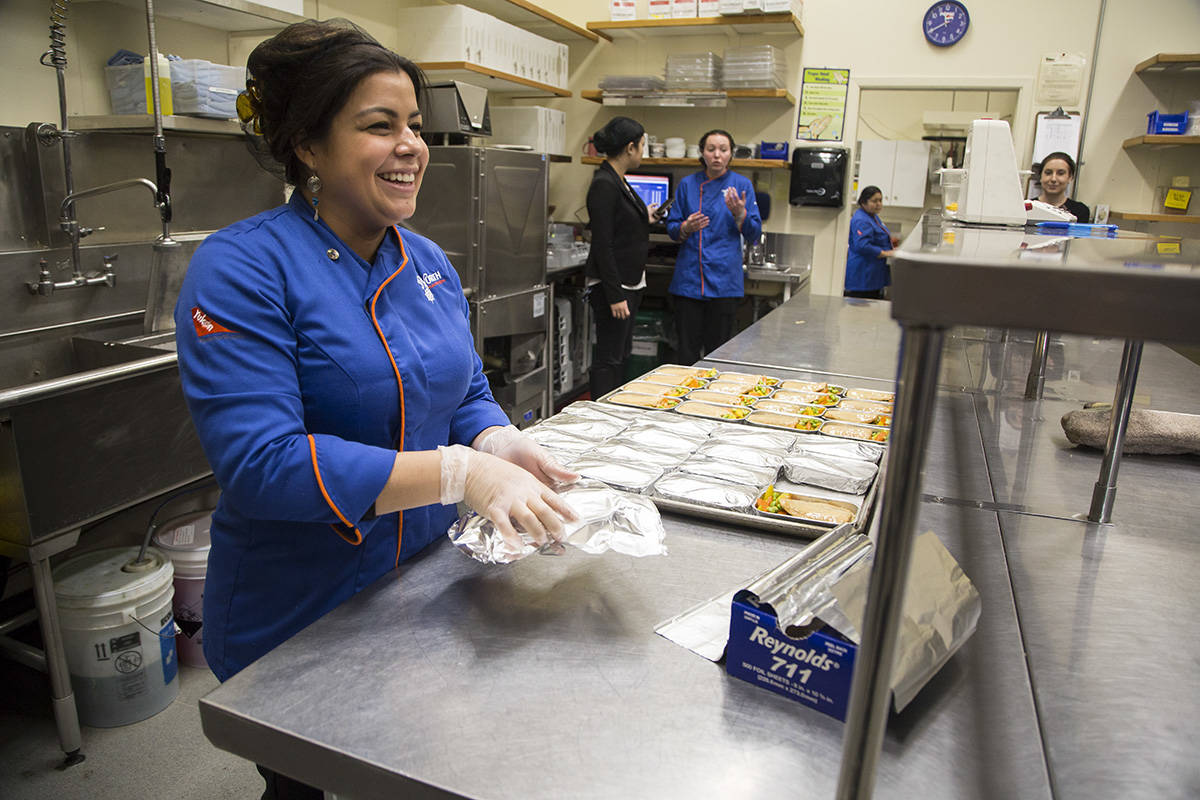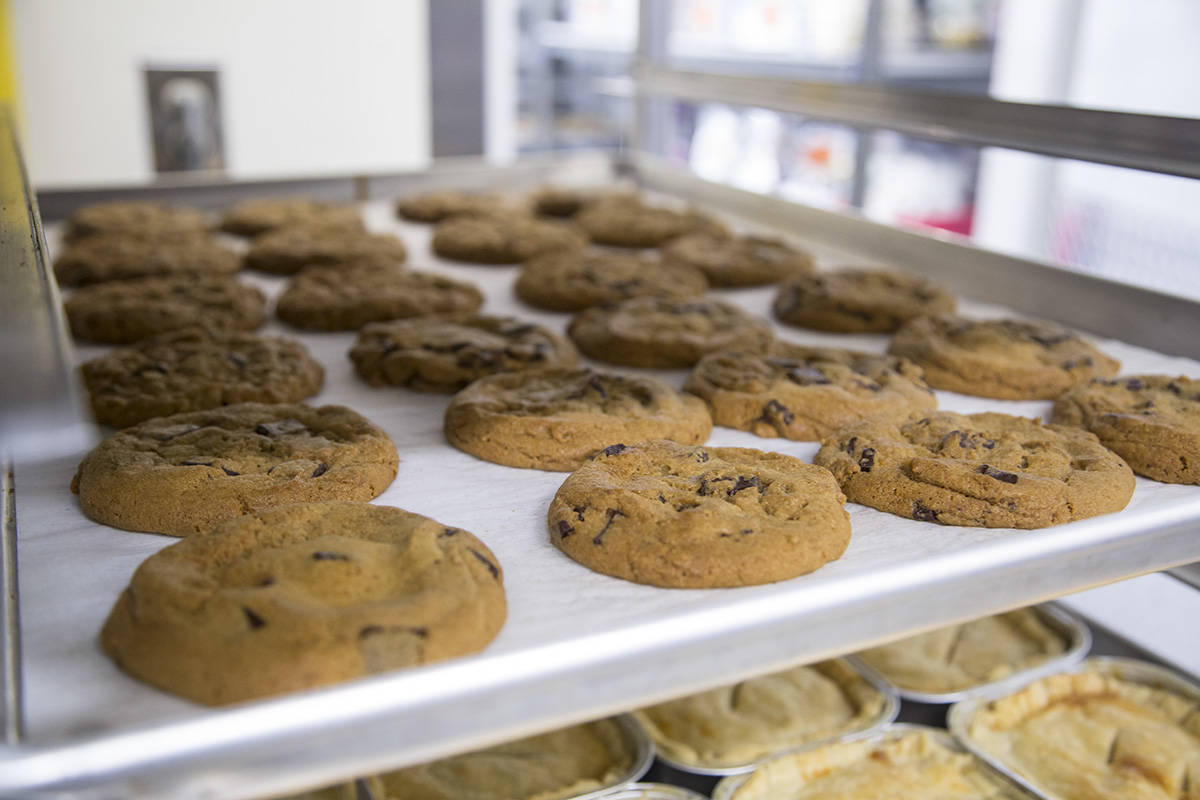The smell of coconut curry and freshly-baked pie crust hits you as soon as you open the door to Air North’s kitchen. Immediately to the left are two long, metal tables covered with at least a hundred paper plates arranged in neat rows, the beginnings of deli platters — crackers, cheese cubes and slices, small bunches of green grapes — are starting to take shape on each of them.
Beyond the tables in the room next door is the source of the smell: a handful of women wearing deep-blue uniforms, hairnets and gloves are either ladling out a mild Thai curry sauce over dozens of portions of Arctic char and vegetables on rice, or pulling turkey pot pies out of the oven.
In a time where the majority of airlines in North America have stopped serving (free) food on domestic trips, Air North, based in Whitehorse, is an outlier, serving passengers meals on almost all of its flights. The magic all happens in a small, inconspicuous building just a stone’s throw from the runways at the Whitehorse airport.
“The easiest part of the whole thing is making the product because that’s something we’re very comfortable with doing,” said Michael Bock, Air North’s manager of catering and cabin services, told the News during a recent visit to the facility. “It’s, how do you make it for hundreds of people and how can you supply it and serve it? How will it hold up during transportation?”
The answer: A lot of testing, and a nearly around-the-clock effort.
A typical day at the kitchen starts at 5 a.m., when the day crew comes in to load the breakfast food, prepared by the evening crew the night before, on to the morning flights.
The staff’s usually back at the kitchen by 6 a.m., which is when they begin the in-house, from-scratch baking: loaves, muffins, and, of course, the famous cookies.
The day crew also preps meals for flights later that day — on the morning the News visits, two staff are assembling deli plates for the Whitehorse-Vancouver flights while the rest are making the casserole dishes for the long haul to Ottawa — before the evening crew comes in at 3 p.m. The evening crew is busy loading planes, cooking and getting breakfasts ready until 1 a.m., during which time the kitchen is quiet for four hours until the day crew arrives and starts the cycle all over again.
During peak travel times like Christmas and summer, it’s not uncommon for the kitchen to pump out 1,400 meals a day, Bock said, with closer to 600 a day during off-season.
“It’s quite a complex system when you think about it, because airline catering is pretty different from any other catering sector, where meals are made here in advance and delivered to the aircraft,” Bock said. “It’s almost like a military exercise at times.”
Besides the volume, which fluctuates from flight to flight, the team also needs to create recipes that can stay palatable and presentable through the intricacies of getting it from the kitchen to a passenger’s tray table, said Jaclyn Flaherty, flight kitchen supervisor.
“Every menu item needs to go through the test of freezing, defrosting naturally and then reheating, so we try to do our best to mimic the ovens on the aircraft with our oven here and we get to try a lot of things, but that’s the way to make sure it’s a solid, true recipe,” she said, adding that past successes include breakfast burritos, meatballs and pasta, chicken cordon bleu, chicken parmigiana, chicken pad thai, beef stroganoff, beef bourguignon, and perogies and sausage.
There’s also another key challenge that the kitchen needs to keep in mind — food tastes different at different altitudes, so what might taste good on the ground can seem bland in the air.
“Not that we over-salt the food, but we try to season it as tasteful as we can so people don’t have to put on extra salt when they’re having a meal,” Bock said, noting that some ingredients like cauliflower seem to lose all taste at a certain altitude.
“It doesn’t seem to make a difference when it comes to desserts, though,” he added. “Desserts always taste good for some reason.”
When it comes to the cookies, Flaherty said it may be more than the taste that’s made them so popular amongst travellers.
“I think it’s something about the smell…. Everyone loves (it). It’s a comfort thing, I think, and everyone loves the smell of a warm, fresh cookie,” she said. “So when you’re flying, maybe you’ve been flying all day, you’re coming from overseas and you’re trying to get home, I think that adds an extra element to it.”
And although not quite a secret, Bock said there’s one ingredient that makes it into almost every cookie.
“You’ll find most of them have chocolate chips because the owner of this airline likes his chocolate-chip cookies,” he said. “So almost all our cookies have a chocolate chip in them.”
Contact Jackie Hong at jackie.hong@yukon-news.com

